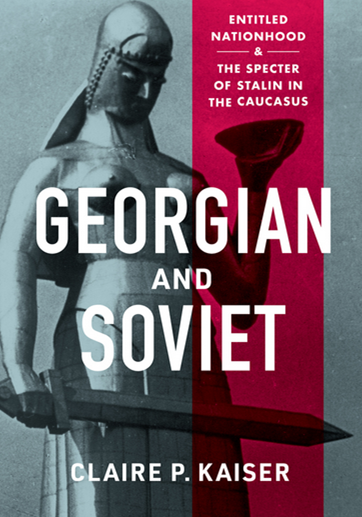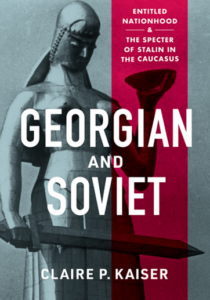
Georgian and Soviet: Entitled Nationhood and the Specter of Stalin in the Caucasus by Claire P. Kaiser

In Georgian and Soviet: Entitled Nationhood and the Specter of Stalin in the Caucasus, Claire P. Kaiser expertly analyzes the ways Georgians carved out and promoted their national rights and identities within the USSR. Kaiser’s work is a useful contribution to the growing body of literature that addresses questions of identity, nation-building, and the negotiation of minority status in the former Soviet Union.[1] By employing the term “entitled” rather than “titular” to describe the most prominent minority group living within each Soviet republic (i.e. Armenians in Armenia, Azerbaijanis in Azerbaijan, etc.), Kaiser centers her book on the rights to which such groups could lay claim. She points out that in the interwar USSR, entitled Georgians largely owed their “special status” to their disproportionately high levels of representation in Moscow. Joseph Stalin, Lavrenti Beria—Chief of the People’s Commissariat for Internal Affairs (NKVD)—and Sergo Orjonikidze—Commissar of Heavy Industry—for example, all came from Georgia. However, Stalin’s death in March 1953, Khrushchev’s de-Stalinization campaign, and the sharp crackdown on the Tbilisi protesters who defended Stalin’s name in March 1956 permanently altered the relationship between Tbilisi and Moscow. It is in the time after these protests, Kaiser argues, that we can best see and understand “Soviet nation-building kartulad (in the Georgian way).” For the most part, by the 1960s and 1970s, Georgians no longer appealed to their co-nationals in Moscow but rather to their rights as entitled nationals in order to reshape their capital, protect their traditions, and guarantee that Georgian would remain their only official language. Kaiser demonstrates that, at times, Georgians’ assertion of entitled rights came at the expense of other national minorities living in Georgia. By alternately leveraging their rights as Georgians, Soviets, and Georgian-Soviets, Kaiser claims, Georgians became “both agents and objects of imperial policies.”
The complex legacies of empire and such fluid self-identification play a major role in Kaiser’s work. Georgian and Soviet opens with a reflection on Tbilisi’s Mtatsminda Pantheon, inaugurated in 1929. Engaging with Katherine Verdery’s concept of “dead body politics,” Kaiser asserts that the remains selected for burial at the Pantheon, which belonged to luminaries of both the imperial and Soviet periods, reveal that modern Georgian and Soviet national development were deeply intertwined.[2] She thus immediately problematizes the narrative that the seventy years of Soviet rule in Georgia strictly represented a “Russian occupation.” In her epilogue, entitled “Stalin’s Ghosts,” Kaiser examines statues, memorials, street names, museum exhibits, and graffiti as means of evaluating collective memory and Stalin’s legacy in his home country. On the one hand, she suggests, contemporary Georgian politicians have actively promoted historical narratives that frame Soviet rule as occupation. On the other, interest in recasting Stalin as a national hero appears to be growing among certain groups. Taken together, Kaiser’s introduction and epilogue indicate that Georgians have and surely will continue to grapple with the tensions of their overlapping identities for years to come.
Nation-building in early Soviet Georgia, Kaiser shows, wove together several smaller ethno-national groups and cast out the outliers to manufacture the appearance of a longstanding, unified Georgian identity. Kaiser analyzes historical monographs and census records published under Stalin to illustrate how early Georgian-Soviet leadership both laid the foundations for the cult of Stalin and constructed the image of an ethnically homogenous Georgian republic. In the lead up to and early years of the Georgian Soviet Socialist Republic (GSSR), Beria, Stalin, and scholars Simon Janashia and Nikoloz Berdzenishvili published historical accounts that elided the popularity of Menshevism in Georgia and depicted Stalin as the unquestioned leader of a universally desired Bolshevik movement. At the same time, changes in census methods gave the artificial impression that between 1926 and 1939, the Georgian republic became more ethnically homogeneous, or—put another way—more Georgian. Combined, these efforts apparently validated the policies passed under Georgian-Soviet leadership and “enable[d] Georgian nation-builders for decades to come.” Mass deportation and repatriation also played significant roles in consolidating the republic along internal ethno-national lines. Kaiser draws on detailed letters that bear questions, requests, and complaints and provide her with a unique window into the ways families and individuals understood such projects.
Kaiser’s argument about the periodization of nation-building kartulad (in the Georgian way) truly crystalizes in the second half of Georgian and Soviet. She explains that, after violently cracking down on protests in 1956, Moscow developed a conciliatory attitude toward Tbilisi. Consequently, although they no longer had the same level of representation in the Central Committee of the Communist Party of the Soviet Union, Georgian leaders actually had more room to generate new kinds of “national political action” after 1956. Kaiser offers valuable insights into the development of this new, national political action. For example, in 1957-1958, Georgian first secretary Vasil Mzhavanadze oversaw the construction of kartlis deda (the Mother of Georgia), a statue commemorating 1,500 years of Georgian history in Tbilisi. In the letter he wrote to the Soviet Central Committee explaining the project, Mzhavanadze both played up Tbilisi’s pre-Soviet roots and glossed over differences between different ethno-national groups making up the country. Mzhavanadze also oversaw the development of the Saburtalo residential neighborhood of Tbilisi. Part of a longstanding effort to create more housing in the republic’s capital, the Saburtalo project became a means of nationalizing—or making more demographically Georgian—the capital city in the 1950s to the 1970s. Finally, when a law proposed in 1978 omitted mention of Georgian as an official, protected, and exclusive national language (a right that had been enshrined in earlier versions of the GSSR’s constitution), letter writers and demonstrators were able to protest the planned change. Between 1956 and 1989, Kaiser demonstrates, Georgians were able to leverage Moscow’s conciliatory attitude to carve out rights that had been denied to entitled nationalities in other republics and construct a Georgian identity that would endure beyond the collapse of the Soviet Union.
One of Kaiser’s most important—and perhaps, for some, most controversial—contributions to the field lies in her discussion of the rights of other minority groups living in Georgia. Kaiser explains how the identities of Megrelians, Laz, Svans, and others were collapsed and enfolded into the larger Georgian national identity under Stalin, ultimately allowing these minority groups to lay claim to entitled Georgian rights. When concerned about the status of their rights, Armenians, Azerbaijanis, and Russians living in Georgia could usually appeal to their own national republics, family nearby, or allies in Moscow. But, according to Kaiser, ethno-national groups belonging to their own sub-republics within Georgia, including Adjarans, South Ossetians, and Abkhaz, “rarely saw the benefits” their own entitled status brought them. Of these groups, Kaiser most prominently vocalizes Abkhaz grievances. She lists, for example, the ways in which Lavrenti Beria attempted to forcibly assimilate Abkhazia into Georgia during the Great Terror of the 1930s. Later, she goes on to describe how, beginning in the 1950s, scholarly debates about early Abkhazia’s history further strained Georgian-Abkhaz relations.
This story’s stakes are not merely academic, and Kaiser’s work opens channels for further investigation, particularly for discussions about the autonomous republics in Georgia. Over several decades, the central Soviet leadership created and enforced a system in which entitled nationalities had incentives to force the assimilation and rewrite the histories of minority populations. Given that Russian President Vladimir Putin uses such longstanding grievances to his advantage in present-day South Ossetia and Abkhazia, how should historians frame such repressions? Georgian and Soviet is a well-researched, artfully crafted, and compelling piece of scholarship. Graduate students and historians alike will find this book offers convincing insight into both Soviet nationalities policies and Georgian history.
Molly Walker is a PhD candidate in the History of Science Department at Harvard University. Her research focuses on the social meanings and uses of infectious diseases in the Soviet Union and twentieth-century Georgia.
Georgian and Soviet: Entitled Nationhood and the Specter of Stalin in the Caucasus
By Claire P. Kaiser
Publisher: Cornell University Press
Hardcover / 294 / 2023
ISBN: 9781501766794
References
[1] See, for example, Georgia after Stalin: Nationalism and Soviet Power, eds. Timothy K. Blauvelt and Jeremy Smith (Abingdon: Routledge, 2016) and Terry Martin, The Affirmative Action Empire: Nations and Nationalism in the Soviet Union: 1923-1939 (Ithaca and London: Cornell University Press, 2001).
[2] Katherine Verdery, The Political Lives of Dead Bodies: Reburial and Postsocialist Change (New York: Columbia University Press, 2000).
Published on July 12, 2023.




